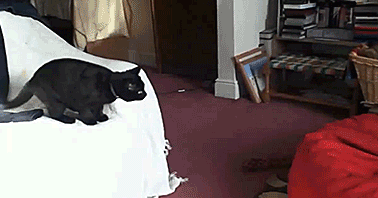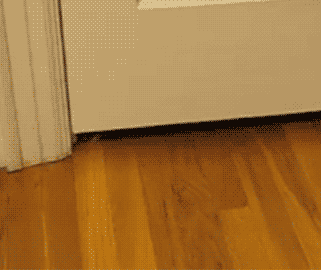When Michael and I were looking for apartments, we learned a lot in a very short amount of time. We knew vaguely for months that we wanted to move out. We didn't actually start looking until the end of July, and moved in September 15th. It was a crash course in apartment hunting.

Not quite that easy.
First, we considered living with a friend of mine. Her lease was up and needed a new place to live asap. It seemed logical that since she needed help, Mike and I should take advantage of the opportunity. We looked in the paper and followed some leads on two bedroom apartments. Some were quite nice, others were downright scary. But, when we sat down and really looked it over, all these bigger apartments split between 3 were just too expensive compared to smaller one bedrooms split between two. Now, we have a lovely place of our own, and are settling in quite nicely. We still have things to do, pictures to hang on the wall, places to find to put things away, and a few odds and ends to buy. But we are glad the hunt is over, this moving in and making an apartment a home is the fun part.

Like a Boss.
So I want to share some tips I learned as I was figuring this mess out.
1. Looking is free
1. Looking is free
It doesn't matter if you're ready to move out tomorrow, or if you're lease doesn't end for another 6 months. Get acquainted with what is available so you know what criteria you want to prioritize. Get to know what the average apartment is like in the area, and what you get for your money. Higher price doesn't necessarily mean better apartments, nor visa versa. Personal experience is best to really get a feel for what you get.
2. Organize your findings
While looking, cut out/print out apartments that are interesting to you. Then, pull up a spreadsheet and make a table. I organized lists into the following columns: Location (by town), number of bedrooms/bathrooms (this was relevant when we were looking at 1 and 2 bedrooms), cost of rent, utilities included, parking situation (on/off street), pet friendly (yes/no for cats, Mike and I want a cat someday so this was relevant for us), and a column for a brief description either based on the ad or personal description after we saw it. After a while I added a last column for additional information about when we visited and if we liked it or not, to help make a decision based on some we narrowed down.
3. Budget
Alright, now you have one side of the coin all etched out. Now for the other side. You know what's out there, now to know what you can possible have. Budgeting actually isn't that hard, it's about organizing. Having the information all in one place is most of the battle. First, write down income per month. Not sure? Luckily today you can easily log into your bank online, check out your last few months of deposits totals and calculate an average. Then, list necessary spending. This is things besides random shopping trips, restaurants and bars. Things like student loans, car loans, and average gas per month (again, extrapolate from the handy dandy bank statements or credit card statements)
Tip: What to make this even easier? Put everything on the same card. To help build my credit score, my parents taught me to never spend more than $15 in cash if I didn't need to. Everything above that threshold goes on my Discover card. But the caveat to that is NEVER to spend more money than you have. I treat my Discover card like a debit card. I have it automatically set to be paid in full every month. This way I'm not spending money I wouldn't have spent anyway, but I'm building credit and cash back every time. That, and most of my spending is on one statement every month. I get that bill and the total is listed in bold right on top.
Do the math, subtract your required spending from your income, and ta-da! You now know how much moolah you have to spend on other stuff each month like rent, utilities, and food.
There hasn't been a gif in a while. Here's a cat playing Jenga.
4. Phase 3 is profit, but what's phase 2?
Yeah okay this is step 4, but you understand the reference. This part is all on you. Look at what you've got from steps 1-3, and weigh your options. Would you prefer having/buying your own washer and dryer for your apartment, or do you not mind going to the Laundromat? Do you think you'd prefer less rent each month with more utilities in your name? Or does having a set rent cover most of your utilities seem better so you don't have to worry about usage? Tip: If you are paying for water, see how long it takes to get hot if you can. It would be annoying to have to pay for ten minutes of letting the tap run just to get it warm enough to shower. Our apartment the bathroom gets hot quickly, but the kitchen water takes forever. Thankfully water is included with rent so we don't worry about letting it run until it's hot enough to wash dishes. Compare what apartments interest you, and compare pros and cons of each. Compare costs of utilities included/not included in the apartments that interest you. I found this article was exceedingly helpful in making that decision. For example, heat is the most expensive utility, and living in northeast Pennsylvania means using the heat 8 months out of the year. Therefore we wanted a place that included heat in the rent, knowing it would be worth it not to worry about turning up the heat on those below zero January days. In fact, the whole site is full of useful articles if you want to read up and get more insight on renting apartments.
5. Okay, I know which apartment I want. Now what?
My intent on this blog post was to just go over the hunt. There's still a lot to do once the choice is made, but I know the hunt is the hardest part. I always feel better after a decision is made. The next things to do are to set up a time to sign the lease, write the check (usually security + one month rent), and get the keys. Get an official move in date. Ask the landlord or previous tenant what companies provide the utilities that are in your name and get them switched over as of the date of move in. This can usually be done easily online. Take pictures of the empty apartment, any scuffs, scratches, dents, stains, and either save the SD card with the lease (the metadata has date/timestamps) or have them printed with date stamps. This is a CYA if your landlord wants to charge you for damage when you leave that you didn't do. Pack your stuff in boxes, gather some friends (preferably one with a pick up truck, or just hire a U-Haul) and get your stuff in!

Well that was exhausting. Time for a nap?
Now I don't claim to be an expert on any of this. All of the above is just based on my own experiences in my own first apartment hunt. I hope my tips are helpful to anyone else looking to move out. Definitely do your research, and MyFirstApartment.com is a huge help.
Much love to all my readers!
Much love to all my readers!
I'm outta here.


No comments:
Post a Comment